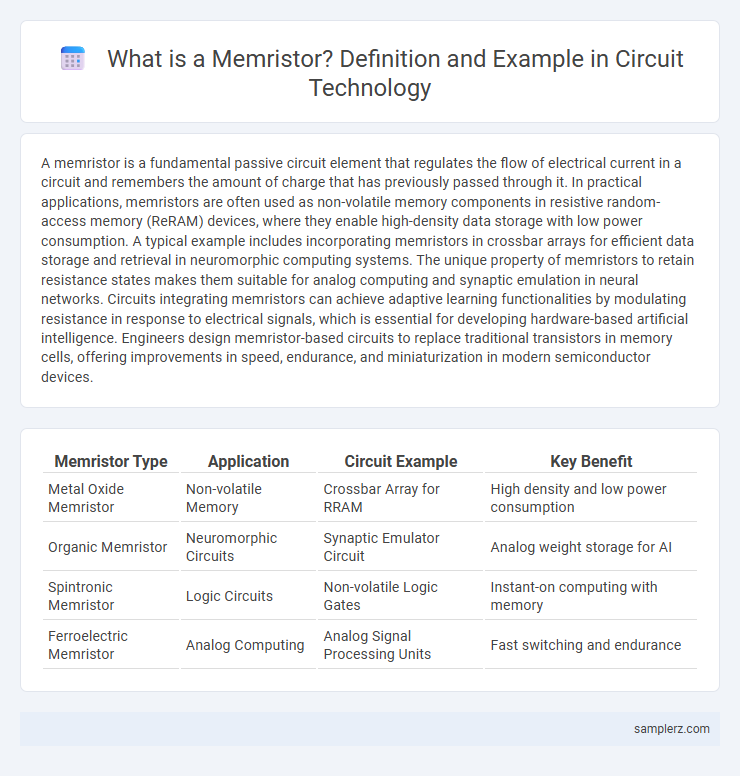A memristor is a fundamental passive circuit element that regulates the flow of electrical current in a circuit and remembers the amount of charge that has previously passed through it. In practical applications, memristors are often used as non-volatile memory components in resistive random-access memory (ReRAM) devices, where they enable high-density data storage with low power consumption. A typical example includes incorporating memristors in crossbar arrays for efficient data storage and retrieval in neuromorphic computing systems. The unique property of memristors to retain resistance states makes them suitable for analog computing and synaptic emulation in neural networks. Circuits integrating memristors can achieve adaptive learning functionalities by modulating resistance in response to electrical signals, which is essential for developing hardware-based artificial intelligence. Engineers design memristor-based circuits to replace traditional transistors in memory cells, offering improvements in speed, endurance, and miniaturization in modern semiconductor devices.
Table of Comparison
| Memristor Type | Application | Circuit Example | Key Benefit |
|---|---|---|---|
| Metal Oxide Memristor | Non-volatile Memory | Crossbar Array for RRAM | High density and low power consumption |
| Organic Memristor | Neuromorphic Circuits | Synaptic Emulator Circuit | Analog weight storage for AI |
| Spintronic Memristor | Logic Circuits | Non-volatile Logic Gates | Instant-on computing with memory |
| Ferroelectric Memristor | Analog Computing | Analog Signal Processing Units | Fast switching and endurance |
Introduction to Memristors in Modern Circuits
Memristors, as fundamental passive circuit elements, enable non-volatile memory storage and neuromorphic computing applications due to their ability to retain resistance states without power. In modern circuits, memristors are utilized in crossbar arrays to achieve high-density memory and in analog computing systems for synaptic weight emulation. Their integration offers significant advancements in reducing power consumption and enhancing computational efficiency in emerging technologies.
Basic Memristor Circuit Configuration
A basic memristor circuit configuration typically consists of a memristor connected in series with a voltage source and a load resistor. This setup enables the observation of the memristor's resistance change based on the history of the applied voltage and current, showcasing its non-volatile memory properties. Applications include analog memory storage and neuromorphic computing, where the memristor's unique hysteresis behavior is exploited for synaptic emulation.
Memristor-Based Memory Cell Designs
Memristor-based memory cell designs, such as the 1T1R (one transistor-one memristor) configuration, enable non-volatile storage with high density and low power consumption. These memory cells utilize the memristor's resistance switching properties to store data, offering faster write/read speeds compared to traditional flash memory. Integration of memristors with CMOS technology enhances scalability and endurance, making them promising candidates for next-generation memory architectures.
Analog Signal Processing with Memristors
Memristors enable efficient analog signal processing by performing real-time filtering and adaptive control in circuits. Their variable resistance properties allow dynamic tuning of signal amplitude and frequency, enhancing edge detection and noise reduction in analog systems. Integration of memristors in neuromorphic circuits facilitates low-power, high-speed processing for analog computing applications.
Memristor-Enhanced Logic Gates
Memristor-enhanced logic gates leverage the unique resistive switching properties of memristors to improve circuit efficiency and reduce power consumption. These gates enable non-volatile logic operations, allowing data retention without continuous power supply, which is beneficial for low-power computing and neuromorphic applications. Implementations in AND, OR, and XOR gates demonstrate significant advancements in speed and miniaturization compared to traditional CMOS-based circuits.
Neuromorphic Circuits Using Memristors
Memristors serve as synaptic elements in neuromorphic circuits, enabling efficient analog computation by mimicking biological neural networks. Their ability to retain resistance states without power supports low-energy, scalable artificial neural network implementations. Integrating memristors in crossbar arrays enhances pattern recognition and associative memory functions critical for advanced AI hardware.
Programmable Resistive Networks with Memristors
Programmable Resistive Networks with memristors enable adaptive circuit functionalities by dynamically adjusting resistance values based on electrical stimuli, improving efficiency in neuromorphic computing and signal processing. These networks leverage the non-volatile memory property of memristors, allowing reconfiguration of circuit paths without continuous power consumption. Integration of memristors into resistive networks facilitates scalable and low-power hardware implementations for artificial neural networks and analog computing systems.
Memristor Oscillator Circuit Examples
Memristor oscillator circuits utilize the unique nonlinear resistance properties of memristors to generate stable oscillations, making them ideal for compact, energy-efficient signal sources in neuromorphic computing and wireless communication. Examples include memristor-based relaxation oscillators, where the memristor's resistance modulates the frequency and amplitude of voltage oscillations in RC or LC circuits. These circuits demonstrate faster response times and lower power consumption compared to traditional oscillator designs, highlighting the memristor's potential in next-generation integrated circuits.
Integrating Memristors with CMOS Technology
Integrating memristors with CMOS technology enables the creation of non-volatile memory cells that improve data storage density and energy efficiency in circuits. Memristor crossbar arrays combined with CMOS control logic facilitate neuromorphic computing systems by mimicking synaptic behavior for artificial intelligence applications. This hybrid integration enhances circuit scalability and accelerates processing speeds compared to traditional semiconductor memory architectures.
Practical Prototyping of Memristor Circuits
Practical prototyping of memristor circuits often involves integrating titanium dioxide (TiO2) memristors with standard CMOS technology to demonstrate non-volatile memory applications. Experimental setups utilize memristor crossbar arrays to achieve ultra-dense storage and neuromorphic computing functionalities, enabling efficient analog signal processing. These prototypes validate the memristor's dynamic resistance switching behavior, crucial for next-generation memory and logic circuit design.

example of memristor in circuit Infographic
 samplerz.com
samplerz.com